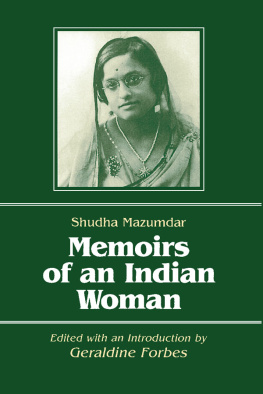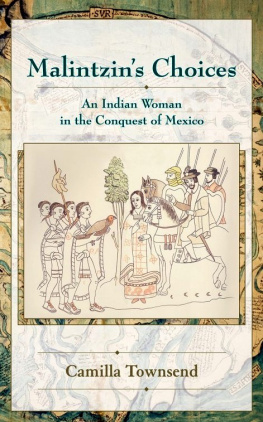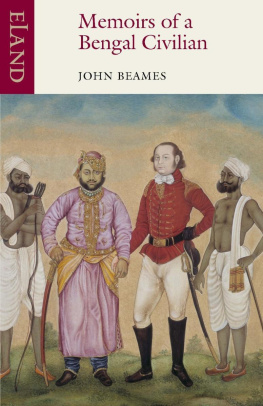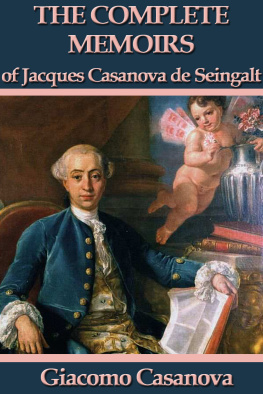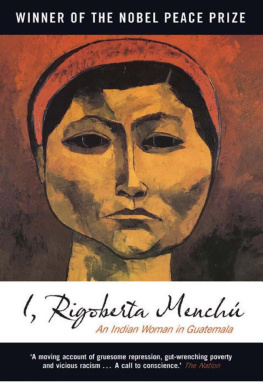Memoirs
of an Indian
Woman
Shudha Mazumdar
Memoirs
of an Indian
Woman
Edited with an Introduction by
Geraldine Forbes

An East Gate Book
An East Gate book
First published 1989 by M.E. Sharpe
Published 2015 by Routledge
2 Park Square, Milton Park, Abingdon, Oxon OX14 4RN
711 Third Avenue, New York, NY 10017, USA
Routledge is an imprint of the Taylor & Francis Group, an informa business
Copyright 1989 Taylor & Francis. All rights reserved.
No part of this book may be reprinted or reproduced or utilised in any form or by any electronic, mechanical, or other means, now known or hereafter invented, including photocopying and recording, or in any information storage or retrieval system, without permission in writing from the publishers.
Notices
No responsibility is assumed by the publisher for any injury and/or damage to persons or property as a matter of products liability, negligence or otherwise, or from any use of operation of any methods, products, instructions or ide as contained in the material herein.
Practitioners and researchers must always rely on their own experience and knowledge in evaluating and using any information, methods, compounds, or experiments described herein. In using such information or methods they should be mindful of their own safety and the safety of others, including parties for whom they have a professional responsibility.
Product or corporate names may be trademarks or registered trademarks, and are used only for identification and explanation without intent to infringe.
Library of Congress Cataloging-in-Publication Data
Mazumdar, Shudha.
Memoirs of an Indian woman / by Shudha Mazumdar: edited by
Geraldine Forbes.
p. cm. (Foremother legacies : autobiographies of women
in Asia, Africa, Latin America, and the Middle East)
Reprint. Originally published: The pattern of life. Columbia, Mo. :
South Asia Books, 1977.
Includes index.
ISBN 1-56324-552-3
1. Mazumdar, Shudha. 2. WomenIndiaBengalBiography.
I. Forbes, Geraldine Hancock, 1943- . II. Title. III. Series:
Foremother legacies.
HQ1742.M38 1989
305.4095414092dc20
[B]
89-10272
CIP
ISBN 13: 9781563245527 (pbk)
I first met Shudha Mazumdar in 1970 when I was doing research on Jogendro Chandra Ghose (18421902), the leader of the Indian Positivist Society. Ghose had lived in Kidderpore, a suburb of Calcutta, and when I went in search of his private papers I located the Mohun Chund mansion where he had lived. Ghoses descendants, who occupied the mansion at that time, told me that Mrs. Shudha Mazumdar was the family historian. When I went to see her at her home on Robinson Street, she shared with me a few pamphlets written by Jogendro and some photographs of the mansion as it looked in the early part of this century, and she helped me locate Jogendros direct descendants. As we became better acquainted, Shudha showed me copies of her published work and, eventually, her unpublished memoirs.
Shudha Mazumdar had translated the Ramayana (published first by Bharatiya Vidya Bhavan in 1953 and in its second edition by Orient Longman Ltd in 1958), and a few of her essays and short stories had been published in magazines. I read through the materials she gave me, and we talked over tea. No one who has met this lady with a twinkle in her eyes can resist her for long; she is an irrepressible raconteur. Before long, I was urging Shudha Mazumdar to tell me more about her life. In response, she opened a cabinet and handed me a manuscript of over five hundred pages. She had first thought about writing her memoirs when Roy North, then an editor with Orient Longman in Calcutta, urged her to do so. In 1960 Shudha Mazumdar began work on a manuscript. The result was a rather long rambling memoir which began with her birth and broke off (because she was so busy) in the 1930s. It was then 1965 and Shudha was overwhelmed by her responsibilities to various social agencies, the manuscript was approximately 550 typed pages, and Mr. North had left Orient Longman.
I read through the manuscript, written in English, and was enchanted. Ready to leave Calcutta to continue research in London, I told Mrs. Mazumdar that I thought it would be wonderful if her memoirs could be published. We agreed that I should take a copy of the manuscript with me so that I could discuss it with my mentors. Professor Edward Dimock and Dr. Manisha Roy, then both at the University of Chicago, read the manuscript and urged me to edit it as soon as my dissertation was finished. Subsequently, I spent the summers of 1972 and 1973 in India, meeting frequently with Shudha Mazumdar to discuss how best to edit the manuscript and reading extensively about the lives of Indian women in the late nineteenth and first half of the twentieth centuries. I returned to India to continue my research on the womens movement in India during the academic year 19751976. Shudhas memoirs were first published in 1977. During research trips in 1980 and 1983, and shorter trips to participate in conferences in 1984 and 1985, I continued to spend a great deal of time with Shudha Mazumdar. More recently she has been engaged in writing the second part of her memoirs.
Both Mrs. Mazumdar and I had been told that the original manuscript would be unpublishable (except by a vanity press) unless it was edited to reduce its size and introduce some form. What emerged differs little from the original, except that this version is shorter, omits some of the long digressions about Indian history and religion, and contains far fewer Bengali words. Some sections of the original manuscript have been shifted to achieve chronological continuity, and photographs that I copied from Shudha Mazumdars personal collection have been added. The original editing was a joint project. The passage of time has wrought important changes in our working relationship. By the time this volume appears, Shudha Mazumdar will have celebrated her ninetieth birthday. Because she suffers from cataracts, she has been unable to read through the second edition, but she maintains an avid interest in the development of the manuscript. We continue to correspond and our discussions about the volume have been aided by the efforts of her grandson, Suman Mazumdar, who now resides in Texas. He and I frequently discuss the manuscript and, from time to time, he poses questions in his phone calls home.
It was almost twenty years ago that I first read this manuscript. What began as an intellectual enterprise is now embedded in many aspects of my life. The experience of working with Shudha Mazumdar has had repercussions for my ever deepening relationships with women in India.
G.F.
Syracuse, New York
February 1989
Note on Transliteration
There is no set transliteration scheme for this work. In all cases an attempt has been made to use the most common spellings for the Indian words used. Since this book is intended for a general audience, it was felt that using the common forms would be of more value than forms that are acceptable according to one of the transliteration systems.
This is an Indian womans story of the period between 1900 and the early 1930s. It was a momentous time for India: the nationalist movement had become a mass movement; the British colonial power doled out representative institutions; and proponents of Indias two major religions, Hinduism and Islam, had become competitors in newly created political institutions. This is how the story of twentieth-century India is usually toldas the rise of the freedom movement culminating in partition and nationhood in 1947. Shudha Mazumdar writes of the period not as one of its significant players (her name remains unrecognized by the power brokers), but as a middle-class woman aware of and interested in the events happening around her. She participated in these events: secretly reading proscribed literature about the revolutionaries, preparing bandages for the volunteers who went to fight in World War I, attending a Congress meeting to hear Mohandas K. Gandhi speak, and going to watch the parade when young Congress Volunteers first wore military uniforms. From her vantage point, however, political issues have always been peripheral, never central.



